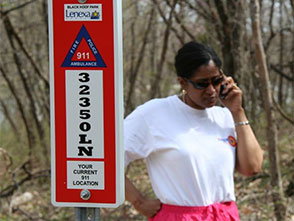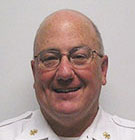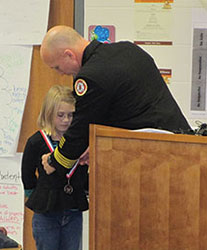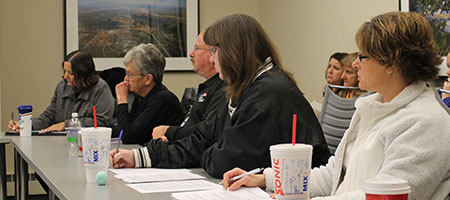
DECEMBER 2014
Trail marker training and information available
|
The GeoLynx mapping software used at regional PSAPs has two map layers that allow dispatchers to help trail users during an emergency. The first map layer shows trail data and the second layer includes trail marker location points. The trail marker location points provide telecommunicators with information to determine the whereabouts of the caller. The trail marker information supplements, but does not replace, the longitude and latitude information provided during a phase II wireless call.
The Kansas City region has approximately 4,400 square miles of green space and approximately 700 miles of existing recreational trails. With this significant amount of trail miles, individuals biking and hiking throughout the metro often cross jurisdictions. To ensure trail markers are coordinated at the regional level, local governments and public safety agencies can adopt the region-wide trail addressing system.
Once trail markers are established in a community, local public safety professionals need to be trained on marker designations and accessing location information in GeoLynx. MARC staff and regional partners built tools into GeoLynx making it easy for telecommunicators to navigate the trails system. More information on how to use trail mapping information is available on the 9-1-1 Intranet.
"Having the trail signs in place provides an extra sense of safety for citizens in our community, especially for folks who like to walk and bike on our trails," said Mike Shelton, emergency manager for the city of Riverside.
For more information about installing trail markers or GeoLynx trail mapping training please email Saralyn Hayes or call 816-701-8314. More information about the project can be found in the Kansas City Regional Trail Safety Initiative white paper.
9-1-1 education materials available for schools
|
Regional 9-1-1 mascot: |
The Mid-America Regional Council has 9-1-1 educational materials designed for children ages 5 to 8. Materials, including an instructional DVD, are available for public safety professionals and school teachers in the nine-county Kansas City region. Children will learn how to dial 9-1-1, when it is and is not appropriate to dial 9-1-1, and how to answer the telecommunicator's questions. Also, a member of your agency can dress up as the regional 9-1-1 mascot, Cell Phone Sally.
"We have been visiting our local schools for many years," said Peggy Doss, dispatch supervisor for Sugar Creek Police and Fire. "It's great going to the schools and educating the children. Most importantly, we know that this type of education can save lives."
If your PSAP is interested in providing 9-1-1 instruction at a local school or community event, please email Sally McGraw or call 816-701-8330.
Public Safety Program welcomes new employee
|
Ben Chlapek, public safety communications training coordinator |
Ben Chlapek is the new public safety communications training coordinator. He is a retired deputy fire chief and served as an Army lieutenant colonel for 36 years. Chlapek is the chair of the National Association of Emergency Medical Technician's Military Relations committee and serves on the Missouri Governor's Advisory Council on EMS. He earned an associate degree in fire science, a bachelor's in chemistry, a master of public affairs and a master of science in homeland security studies.
Chlapek is eager to train regional telecommunicators and public safety professionals. Contact him directly by email at bchlapek@marc.org or by phone at 816-701-8273.
Kansas 9-1-1 Coordinating Council plans statewide NG9-1-1 upgrade
In 2013, the Kansas 9-1-1 Coordinating Council developed a statewide transition plan from the current analog 9-1-1 system to Next Generation 9-1-1 (NG9-1-1). Upgrading to NG9-1-1 is a multi-year project that should be completed in 2017 and requires coordination by local governments and 117 PSAPs.
The current analog system enables call centers to accept voice calls and receive location data. Transitioning to NG9-1-1 will mean that PSAPs have the opportunity to enhance public safety services. Baseline NG9-1-1, as defined by the National Emergency Number Association (NENA), supports multimedia messages, performs call routing, provides for call media logging and enables PSAPs and callers to engage in interactive communications. NG9-1-1 will also rely on standardized geographic information systems (GIS) across the state of Kansas. This will provide near real-time accuracy to identify the caller's location.
As public safety agencies transition to the digital system, some major tasks will need to be addressed. While standardized GIS will improve service provision, it must be developed to include accurate address points, streets centerlines and jurisdictional boundaries across the state. Also, this transition provides an opportunity for local government agencies to collaborate and build a shared 9-1-1 infrastructure, but funding sources must be identified throughout this process.
"It is important to continue providing a high level of service, even as PSAPs migrate from the current environment to NG9-1-1," said Walt Way, director of Johnson County Emergency Communications. "This process will require the Kansas 9-1-1 Coordinating Council to educate the public and collaborate with our public and private sector partners through a detailed plan."
The final design and performance specifications for this project were identified in April
and the council issued request for proposals in June. The council has evaluated vendor responses to provide a statewide NG9-1-1 network and plans to award a contract in
January 2015.
Public Safety program recognizes young hero
|
Deputy Chief Vince Boucher presents |
MARC's Regional Public Safety Communications program and the Kansas City, Missouri Fire Department honored Emma Miller, a local-third grader, and the dispatcher who helped save her mother's life at a 9-1-1 Hero Award ceremony on Nov. 24. The ceremony was held at Barry School and KCFD Deputy Chief Vince Boucher presented the award.
On Sept. 25, Emma dialed 9-1-1 and told Communications Specialist Krystin Judds that she found her mother unconscious on the floor. The girl was at home with her mother and 6-year-old brother and 4-year-old sister.
During the phone call, Emma remained calm and provided personal information, which expedited the process to get emergency crews to the house. Emma followed Judds' instructions and checked that her mother could breathe and her airway was open. When the emergency crews arrived, she was able to answer their questions. Thanks to Emma's quick response, her mother received the medical attention she needed and made a full recovery.
MARC’s Public Safety Communications program works with schools and throughout the metropolitan area to teach children proper use of 9-1-1 in an emergency. The 9-1-1 heroes program recognizes and rewards young people whose actions helped save a life, stop a crime or reduce property loss.
Public safety professionals learn about text to 9-1-1
|
On Friday, Dec. 5, the Regional Public Safety Communications program held two orientations for public safety managers and dispatchers regarding text-to-9-1-1 technology and regional capabilities. MARC staff provided a demo of how this technology operates, discussed appropriate policies and procedures, and provided participants with an opportunity to test run the new technology. Text to 9-1-1 is a service that is currently in testing phases and will be live once testing is complete.
Maintenance Services
If your issue requires immediate attention please call 816-421-2911 any time day or night.
In non-emergency situations, you may email maintenance requests or questions to 911techs@marc.org or call 816-421-2911.
 Remember, it is important to reboot your 9-1-1 workstations at least once each week, Monday through Friday, between 8 a.m. and 5 p.m., when a MARC communications technician is available in case you experience any problems. This will automatically update the GeoLynx map data on your workstation.
Remember, it is important to reboot your 9-1-1 workstations at least once each week, Monday through Friday, between 8 a.m. and 5 p.m., when a MARC communications technician is available in case you experience any problems. This will automatically update the GeoLynx map data on your workstation.
Upcoming Training Opportunities
Jan. 5: Leadership in the Communications Center
Jan. 6: 9-1-1 Stress Management
Jan. 15: Violence in Public Settings
Jan. 20: 9-1-1 Liability
Jan. 22: Interoperable Communications
Jan. 27–28: Advanced Communications Training Officer (CTO)
Jan. 29: Refresher for the Experienced Telecommunicator A (RET A)
Feb. 2–7: Basic Telecommunicator Training
Feb. 10: Refresher GeoLynx
Feb. 12: Bullying in the PSAP
Feb. 17–18: Negotiations Training for Telecommunicators
Feb. 24–25: Basic Fire Communications
Feb. 26: 9-1-1 Equipment Training
See a complete list of upcoming
9-1-1 training opportunities and GTI courses included in the
9-1-1 training consortium membership.
PSAP Managers Forum
The PSAP Managers Forum is an excellent resource for managers and supervisors to share and exchange ideas, concerns and suggestions.
Have a story you want to share?
Email Paul Lampe or call
816-701-8366.
600 Broadway, Suite 200 | Kansas City, MO 64105
ph: 816-474-4240 | fax: 816-421-7758
www.marc.org/publicsafety | e911@marc.org




